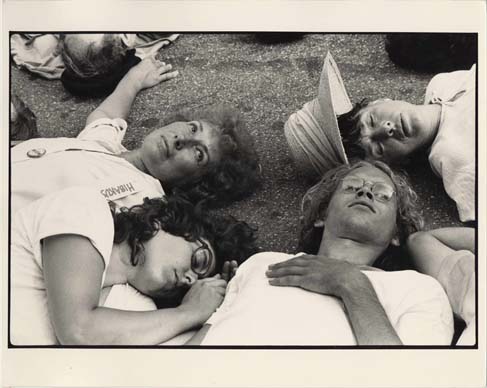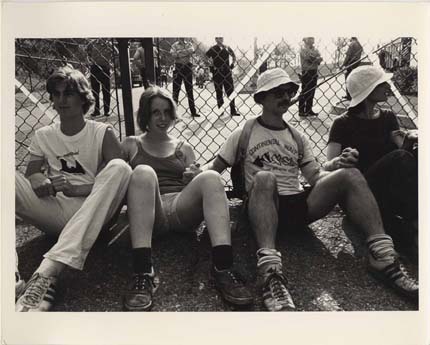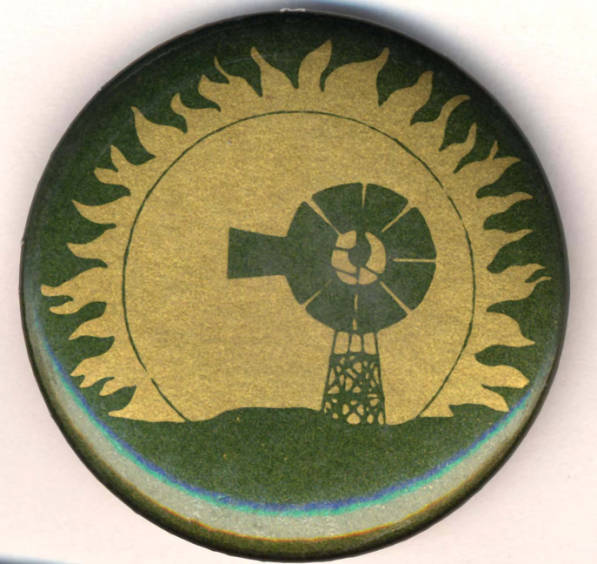Anti-Nuclear Proliferation
(Photos below)
After the end of the Vietnam War in the mid 1970s, peace
groups, such as Women Strike for Peace, renewed their focus on
protesting nuclear testing and the escalating Cold War arms race.
Concerned with the survival of the human race, activists aimed to
educate the public concerning the harmful effects of nuclear weapons and nuclear waste,
advocate for nuclear disarmament, and legislate nuclear power.
With the 1979 Three Mile Island Nuclear Generating Station accident,
outside of Harrisburg, Pennsylvania, many in the U.S. became aware of
the potential dangers of even civilian nuclear power. Anti-nuclear
activists believed that the material created at civilian-run nuclear
power plants could be used by the military to create weapons.
Well-regarded scientists, such as physicist Carl Sagan and Australian
pediatrician Helen Caldicott, spoke out in the media about the horrors
of “nuclear winter” - the complete destruction of the earth and human
life in the aftermath of a nuclear war.
Protest against nuclear weapons was manifested in
demonstrations, legislative efforts, and destruction of military
property. The anti-nuclear movement was the largest
social/political movement in both Europe and the U.S.,
throughout the decade of the 1980s, with protesters numbering in the
millions at some larger events.
As a logical extension
of her Vietnam war protest and feminism, Marder was an activist in the
anti-nuclear movement. She was involved in the movement with WSP,
as well as taking part in some of the more radical protests of nuclear
facilities; including the Women’s Pentagon Action, the Women’s Peace
Encampment for A Future of Peace and Justice at the Seneca Army Depot in
Romulus, New York (1983), and protests at nuclear power plants such as
at Indian Point in New York (1980), Shoreham in New York (1979), and
Seabrook in New Hampshire (1978). Her photography uniquely
captures the determination and community found in the movement.
Sources:
Harriet Hyman Alonso. Peace as a Women’s Issue.
Syracuse: Syracuse University Press, 202-210, 221-222.
Charles DeBenedetti, Charles Chatfield. An American
Ordeal. Syracuse: Syracuse University Press, 1990.
_________________________________________________

Dick Gregory
Event: Continental Walk for Disarmament
Washington, DC
October 16-18, 1976
Prints D 602 - 622
7.5" x 9.5"

Event: Continental Walk for Disarmament
Washington, DC
October 16-18, 1976
Prints D 602 - 622
7.5" x 9.5"

Event: Seabrook, Anti-Nuclear Demonstration
New Hampshire
June 25, 1978
Prints D 800 - 806
7.5" x 9.5"

Event: War Resister's League No Nuclear!
Demonstration
White House, Washington, DC
February 12, 1978
Prints D 855 - 859
6.5" x 9.5"

Event: Anti-Nuclear March and Demonstration
Capital Building, Washington, DC
May 6, 1979
Prints D 890 - 892
9.5" x 6"

Connie Hogarth and David Dellinger
Event: Shoreham, No Nukes Protest
Brookhaven, New York
June 3, 1979
Prints D 903 - 905
9" x 6.5"

Event: Shoreham Nuclear Power Plant, No Nukes Protest
Brookhaven, New York
June 3, 1979
Prints D 903 - 905
6.5" x 9.5"

Connie Hogarth (upper left)
Event: Indian Point Nuclear Power Plant Demonstration, Indian
Point, New York
August 5, 1980
Prints D 915-922
6.5" x 9.5"

Event: Indian Point Nuclear Power Plant
Demonstration, Indian Point, New York
August 5, 1980
Prints D 915-922
7.5" x 9.5"



